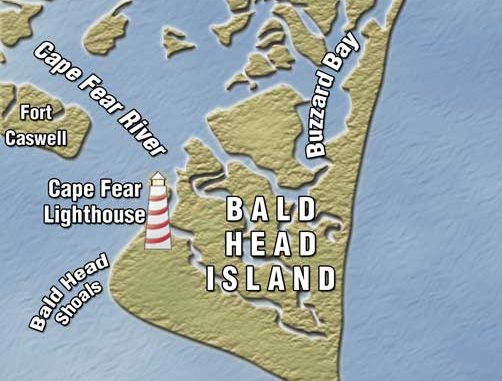
The main problem for southeastern red drum anglers is where they want to fish.
The time of year Cape Fear-area anglers wait for through a seemingly endless winter is here when the calendar indicates May has arrived.
Warm fronts, longer days and the swollen Gulf Stream have warmed the Atlantic Ocean’s waters at the North Carolina coast this month. The heat from the sun promotes the growth of microscopic organisms, which fuel the food chain. Baitfish and shrimp begin multiplying and gather at North Carolina’s inshore waters.
It’s also time for red drum (along with nearly every other saltwater species) to begin eating in earnest and to start the process of bulking up after a lethargic winter.
When the month of flowers arrives, many Tar Heel anglers head for coastal waters in hopes of catching a red drum. However, once they arrive, many don’t have much of a game plan. They’ll fish locations based on good feelings and generally use bottom rigs that will be as likely to catch a sea bass as a channel bass. Unless an angler is retired or are a lottery winner, nice long days on the water are probably a welcome and rare occasion.
But anyone fishing for red drum had better take a serious interest in that pursuit. Make the most out of time on the water by narrowing searches for redfish to the places where drum reside, use the tackle that will draw strikes from spottails and fish lures in a way that will make drum react.
It’s common knowledge that Buzzard Bay (an area of open flats, oyster shell beds with creeks at its periphery northeast of Bald Head Island) is a particularly good area for red drum near the southern tip of the Cape Fear drainage. However, it wouldn’t be wise to tear out on a skiff to Buzzard Bay for the first time and try to cash in on drum without first doing some homework.
The Bay is extremely shallow, especially during low-tide periods, and can be dangerous. That’s not to say anglers should avoid fishing opportunities this region, but they should do so with caution, entering the area slowly with the tide in mind (getting too shallow on a dropping tide can make for a long afternoon).
A great bet for those not comfortable enough to run back into Buzzard Bay is to trim the motor and cruise slowly, searching for oyster beds that attract fish.
Plenty of oyster reefs are sprinkled about the Bay. The best of them will be large and close to deep and shallow water.
Remember, when the water temperature warms, red drum are almost always look for food (which will be in the shallows) and safety (which is deep water).
“If (anglers and boaters new to Buzzard Bay) aren’t careful, they’re gonna get in trouble,” said Captain Brett Stanley of Current Adventure Charters. “And if they’re really not careful, they’re gonna get the bottom knocked out of their boat.”
Many would argue Buzzard Bay is the best red drum area between Surf City and the South Carolina line. Captain Matt Wirt is one of them.
Go to www.youtube.com and search for “Reel Adventure Mitzi.” That search will result in a video Wirt filmed of himself ripping through the Lower Cape Fear/Buzzard Bay area, full throttle on his 17-foot Mitzi Skiff. That film should be all the convincing anyone should need that Wirt has put in his time on the water.
Most sportsmen who read outdoor publications have seen this advice many times — hire a guide to learn the area one wants to fish. Experience and local knowledge are invaluable, while desire to catch fish coupled with ignorance of water conditions aren’t viable substitutes.
Sure, anglers may have to spend a few hundred bucks, but their learning curve will be cut significantly. The insight and know-how an angler stands to gain from a good guide are invaluable, not to mention the savings in destroyed equipment or hours spent trying to push a grounded boat off a mud flat.
A couple of Cape Fear region areas are more friendly to those who don’t have the luxury of fishing every week. The islands near Rich Inlet are prime examples. Figure Eight Island and Lea Island are good drum-holding areas.
When the water temperature has warmed (as occurs during May) drum regularly school just off the beaches of these barrier islands.
“You need calm seas with a light offshore wind so you can get the boat close to the breakers,” Stanley said.
He’ll cruise parallel to one of the islands, blind casting occasionally but really looking to sight a school or red drum. They’re usually hanging out in the breakers, and he can see them through the rolling waves.
If seas are too rough to fish safely, anglers can park boats at the backside of Lea Island and walk the beach, looking for the fish in the shallow water.
Standard red drum lures will work, but a lure that can be cast a long way is ideal. However, simply throwing out a bottom rig with a live mullet or mud minnow will catch redfish in this area. But it’s a good idea to first walk the beaches to spot a school before resorting to sitting and waiting for a school to stumble across bait.
At certain times of the year, good drum fishing can be found well up the Brunswick River. Great bottom structure exists south of the small bridge at U.S. 17 near Leland.
Motorists who traveled across the bridge during January and February probably noticed dozens of boats just downstream. A population of gator trout draws these anglers, who quickly thin the specks. Where a smaller feeder creek joins the main river farther south, the bottom is littered with structure.
One plus of fishing this area is the slow-moving current serves to push boats well enough to imitate a controlled drift. Anglers can cover some serious red drum water by dragging live baits or jigging at this stretch of river.
To say the Wrightsville Beach area is developed is an understatement. Anglers who have fished that region know well the heavy boat traffic of the summer and congestion at the waterway. However, Wrightsville Beach has some good qualities for anglers.
If traveling north to the Lea Island area or south to the mouth of the Cape Fear isn’t an option, red drum may be caught right in the heart of Wrightsville’s commotion.
The waterway at Wrightsville Beach is filled with docks that attract redfish. Not only that, although reds normally are spooky, skittering away at the first sign of an intrusion into their comfort zone, the water traffic is so consistently intense at Wrightsville Beach, the reds have become accustomed to it. They don’t spook easily.
Once anglers locate an area with drum, often fish after fish can be caught at the same area without the school getting lock jaw.
Stanley and Wirt agreed heavy braided line (as heavy as 60-pound test) is a must for fishing docks. Red drum are extremely strong fish and a hooked red will barrel directly toward line-slicing, barnacle-encrusted pilings. Adding a fluorocarbon leader will help prevent fish from seeing the line.
A jig with a twister tail, a GULP lure or a live minnow with 3/8 or 1/2 ounce of lead are good lure and bait choices.
When covering a lot of water or when fishing docks, mud flats or oyster bars, spinnerbait lures such as the Redfish Magic and Bayou Buck are killers. Stanley said he prefers the Bayou Buck model because the shaft is short and stout and won’t break easily (these lures are available at Bug-Em Bait and Tackle in Wilmington).
“The way to pick out a dock is to pick one with the most structure and the most barnacles,” Stanley said. “The bigger and older with the more junk around it the better. If it has been there a while, it’ll hold a lot of life.”
A boat equipped with a trolling motor is a good choice, as the technique employed to fish docks is similar to fishing shallow water for largemouth bass. Anglers may make hundreds of casts, but the tactic can be a fruitful way to land lots of redfish.
When it comes to lure or bait selection, generally speaking those unfamiliar with an area or who don’t have a shallow-draft boat equipped with a trolling motor, should stick to live bait.
The old phrase “90 percent of the fish are in 10 percent of the water” holds true. Many anglers hoping to catch red drum will anchor up at one place and cast artificials repeatedly at the same 60-yard area — which simply isn’t a realistic approach.
If drum are present and if they’re going to strike an artificial lure, they probably will hit it right away. Drum are fairly spooky (especially those that don’t live at Wrightsville Beach proper) and are unlikely to enter an area with lead jigs plopping into the water every 45 seconds.
When fishing in a larger boat that doesn’t quietly and slowly move from one place to another (by using a push pole or trolling motor), usually the best method is to get good, live bait such as shrimp or mud minnows and post up at a “fishy- looking” oyster bed or mud flat at a rising tide, at a deeper pocket near spartina grass or a pocket in the grass during a falling tide.
Anglers should cast out several rods at different areas and depths.
If the area is familiar and the angler knows where fish generally congregate, or when fishing a boat equipped with a trolling motor, soft-plastic jerkbaits, jigs (Gulp or bucktails), and spinnerbaits are tough to beat.
Stanley said many times anglers fish much too fast.
“I tell them to KISS it — Keep It Slow and Simple,” he said.
One of his most-preferred red drum lures for the Cape Fear area is a bucktail jig tipped with a little cut of Fish Bites, an artificial bait that features warm and cold-water formulas.
Stanley said the correct formula makes a difference in the effectiveness of the lure, so anglers should always use the appropriate formula.
He said anglers shouldn’t be afraid to let the lure sit on the bottom. Often, he said, his clients will catch fish while the bait is sitting motionless on the bottom.
Many serious drum anglers, such as Dickson, don’t care to use a trolling motor. He said he thinks a lot of fish are spooked by a trolling motor’s noise.
An angler will see more fish by staying with the push pole or even getting out of the boat, wading and casting.
While Wirt agreed with Dickson about the tendency of trolling motors to make redfish skittish, he uses his trolling motor, even in shallow water.
“I try to use the trolling motor sparingly and set up so the wind will drift the boat across a flat,” he said, “but spooking a fish isn’t always bad.”
In fact, sometimes Wirt will drift across a flat with his outboard engine running. The schools of drum spook, and Wirt said he will make a mental note of the areas where the drum were located.
Since N.C. red drum don’t receive the pressure of those at Gulf states inshore waters, they’ll generally come right back to the same spot, even if he floats directly above them.
Wirt said he’ll then wait for 15 or 20 minutes then sneak back to that spot, ready to sight cast to the school.

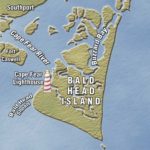
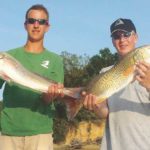
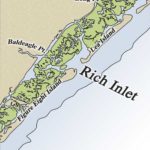
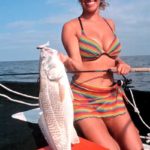
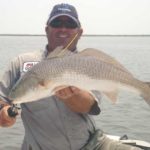
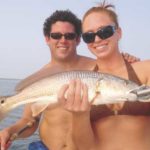
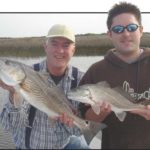



Be the first to comment